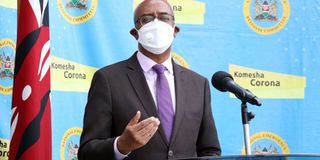Virus to continue taking toll on health sector for six months

Health Chief Administrative Secretary Rashid Aman during a Covid-19 briefing at Afya House, Nairobi. PHOTO | FILE | NATION MEDIA GROUP
What you need to know:
- On Wednesday, the Ministry of Health predicted that the pandemic would peak in the country between August and September.
- If physical distancing cannot be achieved, then easing of restrictions should be reconsidered.
The Covid-19 pandemic will continue putting pressure on the health sector for the next six months, the World Health Organization (WHO) has said.
Speaking at a virtual press conference, WHO Country Representative Rudi Eggers said, “It’s dangerous to let the disease run rampant because deaths will rise exponentially.”
The news comes at a time when countries in sub-Saharan Africa like Kenya, which have widely been praised for early lockdowns, are now bucking the global trend and planning to reopen amid rising infections.
“We don’t know when the peak will be but we are helping Kenya with risk analysis,” said Dr Eggers while receiving a Sh270 million (2.3million Euros) grant from the European Union’s Civil Protection and Humanitarian Aid Operations department (Echo).
GLOBAL APPEAL
The grant, which is part of 30 million Euros the EU has given WHO in response to its global appeal for help to combat Covid-19 worldwide, will be used to train front-line health workers at the national and county levels and to strengthen rapid response and clinical teams in all counties.
“The grant comes at a critical time when we are dealing with community transmission and need urgent response measures to stop further spread,” Dr Eggers said.
On Wednesday, the Ministry of Health predicted that the pandemic would peak in the country between August and September.
“Going forward, we are likely to see more samples test positive and if our models are accurate, our number will rise somewhere between August and September. But nature sometimes does not obey science,” said Health Director-General Dr Patrick Amoth.
Kenya is pondering the best approaches to easing restrictions without importing another wave. President Uhuru Kenyatta has made it clear that he is eager to reopen the economy after partial lockdowns crippled factories, halted travel and kept millions of people largely confined to their homes. But he has reiterated that reopening will be informed by the measures put in place and the counties’ level of preparedness.
EASING RESTRICTIONS
WHO says easing restrictions should be tailored to physical, social, cultural, political and economic contexts and to specific groups and workplaces where solutions can be created that are proportionate to risk.
If physical distancing cannot be achieved, then easing of restrictions should be reconsidered.
But the lifting restrictions is not easy, process as many of the countries that had implemented lockdowns have realised measures to contain the spread of the virus and reopened are now experience resurgence of the virus.
For instance, Singapore had initially been hailed for keeping the virus in check with a strict regime of testing and contact tracing, only for serious outbreaks to emerge later in dormitories housing low-paid foreign workers.
INFECTIONS
The city-state now has the highest recorded number of infections in Southeast Asia with nearly 39,000 cases. Germany, which recently took its first steps in easing restrictions, reported that its reproduction number, which shows how many people a single person can infect with the virus, has risen to 1.1, hinting at the exponential spread and Pakistan is currently considering locking down yet again after they lifted their prolonged lockdown late last month in the country that already had a weak health system.
According to WHO, easing restrictions should be tailored to physical, social, cultural, political, and economic contexts, and to specific groups and workplaces where solutions can be created that are proportionate to risk.
If physical distancing cannot be achieved, then easing of restrictions should be reconsidered.
“It’s dangerous to let the disease run rampant because deaths will rise exponentially,” Noted Dr Eggers.
Lifting of public health and social measures should start by removing those measures that have the greatest local impact first, then gradually extending this removal to broader geographic areas, considering the national epidemiology and priorities.
This will allow for tailored actions and swift redeployment of measures if the number of new cases starts to overwhelm local systems.
At a minimum, two weeks should be left after lifting any lockdown measures to assess the effect on transmission, before proceeding to remove further measures.
“The country is improving in its readiness and it’s expanding this readiness but ultimately, sustained decline, reduced infections and deaths is what will show success,” Dr Eggers acknowledged.





